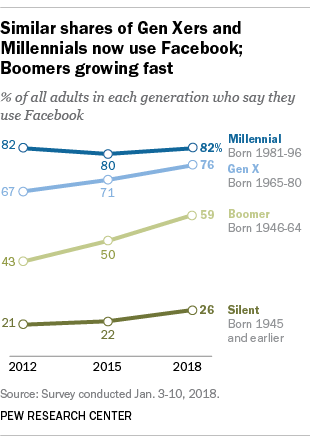November 28, 2018
1. Start with a plan
Every good business strategy starts with a good plan. Social media marketing for small business is no different. Since it’s so easy to use and you can get started with organic posts for free, it might be tempting to dive in and just start posting.
But without a plan, you have no way of knowing what you’re trying to achieve with your social media posts, and no way to measure whether you get there. Taking the time to create a social media plan right upfront will ensure that all your social efforts support specific business goals.
As we outline in our guide to creating a social media marketing plan, you need to:
- Set social media goals and objectives: Create goals that follow the SMART framework—they should be specific, measurable, attainable, relevant, and timely. Base your goals on metrics that will have a real impact on your business, like acquiring customers or raising your conversions rate, rather than simply racking up likes.
- Research the competition: What is your competition up to on social media? While you don’t want to copy them, learning from what others have done is a great way to reduce your learning curve. A competitive analysis and some social listening strategies can give you insight into what’s working and what’s not for other businesses like yours.
- Conduct a social media audit: If you’re already using social media, now’s the time to take a step back and evaluate what you’ve done so far. As part of your audit, you’ll also look for impostor accounts that may be stealing your online thunder. We’ve got a full social media audit template to walk you through the process.
- Find inspiration: You’ve had a look at what your competitors are doing online, but what about other businesses? Take inspiration from the success of small business in all industries. Where can you find these success stories? Head to the business section of most social networks and you’ll find useful case studies. It’s also a great idea to ask existing followers what they want to see more of, then give them exactly what they ask for.
- Create a social media calendar: A social media calendar helps you post the right content to the right social channels at the right time. It should include a plan for your content mix. Try starting with the 80-20 rule: Use 80 percent of your content to inform, educate, or entertain your audience and 20 percent to promote your brand or sell your products.
2. Decide which platforms are right for you
Don’t make assumptions about where your audience spends their time online. Your instinct might tell you that you should skip Facebook and focus on Instagram and Snapchat if you’re targeting millennials, but the data shows that 82 percent of millennials still use Facebook.

We’ve compiled demographics information for all of the major social networks that can help you gauge where your audience spends their time online.
Keep in mind that you can use different social channels to reach different audiences, or to meet different business goals.
And remember that these demographics are just an overview. It’s important to understand how to reach your specific audience. In order to figure that out, you’ll need to make sure that you really…
3. Know your audience
Using social media for small business let you micro-target your audience—but first you need to understand who your audience is. By compiling data on your current customers and then digging deeper with social media analytics, you can develop a solid picture of who’s buying from you and who’s already interacting with you online. Then you can revisit your social media plan to include ways to reach more people just like them.
For example, Jimmy Beans Wool clearly understood its core market was crafty knitters and crocheters across the United States and Canada. But when the company first started, it had limited access to this huge group. The company had an email subscription list of dedicated fans, but that was not a large enough audience to sustain and grow the company.
When Jimmy Beans launched a first-of-its-kind subscription service for yarn samples and supply kits, they used a Facebook lookalike audience to reach people who shared the same characteristics as their existing dedicated fans. The ads brought in 1,000 subscribers in 36 hours—such a massive response that Jimmy Beans had to pause the ad for a few days so they could catch up with the orders. That’s a sure sign that the company understood its audience well and created an offer that spoke directly to their wants and needs.
Using social media marketing, this small yarn shop has grown into a multi-million-dollar business.
4. Build relationships
The unique benefit of social media compared to other marketing channels is that it allows you to talk directly to customers and followers. You can build relationships over time, rather than asking for a sale right upfront. That’s one reason why 93 percent of people who follow small- and medium-sized business on Twitter plan to purchase from the SMBs they follow, according to a report from Twitter and Research Now.
When people engage with your organic content or ads, you can jump in and reply, helping to build trust and form the early stages of a rewarding customer relationship—like SkinnyMint did here:

Facebook Groups are another great way to build community and establish relationships and brand loyalty. Sticking with SkinnyMint, they have a group in which women can show off their weight loss and support each other. The SkinnyMintBabes group has more than 3,300 members who act as brand champions for the product just by showing what they’ve achieved.

Using social channels, you can also build connections and relationships with other entrepreneurs and influencers in your niche. Think your business is too small to work with influencers? Consider that microinfluencers (starting with 10,000 followers) can be incredibly effective for establishing brand trust, and they are often not out of budget range for smaller brands.
5. Expand your audience
Once you have dominated your original market niche, you can use social tools to reach out to new audiences.
For example, the nutritional supplements company GoSupps started as a small business in the United Arab Emirates. Its original audience was primarily made up of bodybuilders. In order to grow the business, GoSupps needed to expand its audience to a more general sports and fitness demographic.
Using Facebook targeting options, the company reached out to new potential customers who were interested in health and fitness. The campaign resulted in a four times return on ad spend, and GoSupps has grown its Facebook Page to nearly 97,000 fans.
While the company still has a strong focus on its original bodybuilder audience, it also posts social content that has broader appeal.
You can also use social media to drive new customers to your local business. For example, Hootsuite geo-search streams can help you monitor and respond to local conversations about your business, and build relationships with other local businesses in your area.
6. Share compelling visuals whenever you can
People have come to expect social posts to include a visual component. Twitter’s internal data, for example, shows that people are three times more likely to engage with Tweets that have visual elements like a video, photo, infographic, or GIF.
Social images drive real-world action, too. More than half of millennials have made travel plans or visited a restaurant based on an image or video a friend shared on social.
Instagram, Pinterest, and Snapchat, in particular, are visual-first networks. If your content doesn’t look good, no one will stop scrolling to read what you have to say.
The Peach Truck has a business that’s practically made for Instagram. They sell fresh Georgia peaches across the United States, and all those gorgeous peaches are perfect for sharing in social posts. They’ve got a beautiful feed on Instagram and they’re making great use of Pinterest, too.

Social media was a critical component of The Peach Truck’s early growth. They started out literally selling their peaches from the back of a truck, and they used social ads to get the word out about where they would be each week. More than half of the people who came out to buy their peaches heard about the company on Facebook.
Even if you’re not selling beautiful fruit, it’s important to use great imagery in your social posts to increase engagement. For service businesses in particular, this can be a bit of a challenge. But every business can tell its story through photos and videos. Maybe you can showcase your company culture with images from inside your office.
Bonus: Get the step-by-step social media strategy guide with pro tips on how to grow your social media presence.
Another option is to use stock photos. There are plenty of free, high-quality photos online that you can legitimately use in your social posts. We’ve compiled a list of 21 free stock photo sites you can use to find images for your posts. Just make sure you stick to using appropriately licenced stock photography (like you’ll find on the sites in our list), since using random images you find online is definitely not okay and can get you in some serious trouble.
If it’s GIFs you’re looking for, check out Giphy.
7. Focus on quality over quantity
The sheer number of social media marketing options for small business might seem overwhelming—but you don’t need to do it all. It’s much more important to create quality content on a couple of key channels where you can really connect with your audience than it is to have a presence on every single social network.
Above all, be sure that your social posts offer value. If all you do is pitch and sell, there’s very little motivation for people to follow you. Remember, social marketing is all about building relationships. Be human. Be honest. Provide great content.
This is important, and you can’t fake it. According to a survey from Stackla, 86 percent of consumers say authenticity influences which brands they like and support.
You can’t do it all, and there’s no reason to try. Reach out to your audience in the places where they’re already spending time online. Focus on using one or two social channels really well, at least to start. Once you’ve got those mastered, you can build from what you’ve learned and expand your efforts.
8. Use the right tools
The secret to effective social media use is to take advantage of tools that automate or simplify much of the work. There are loads of tools to help boost your productivity so you can take make great use of social media marketing for your small business without having a full-scale social media team.
- Engagement management: Social media is not a broadcasting system—it’s a way to engage with customers and fans. Social media management tools like Hootsuite can help you centralize all mentions and messages directed at your company in one dashboard so you can respond and engage without having to log into each of your individual social media accounts.
- Analytics: We linked to information about analytics for all of the social networks above, but getting all of that information in one place can help you get a better picture of your social efforts overall. Brandwatch allows you to create in-depth reports, while Hootsuite Insightsprovides a great overview of how well you’re capturing the conversation in your niche.
- Graphics: If you’re having trouble creating eye-catching for your posts, turn to tools that will help get the job done. VSCO, Piktochart and Canva are some of our favorites. You can find more photo-editing tools in our post on how to edit Instagram photos.
- Content curation: It can be a struggle for small businesses to come up with new content to share every day. Content curation—the art of sharing quality posts from others (with credit, of course) can be a great way to provide value for your followers and keep them engaged. Tools like BuzzSumo and Pocket can help you find and organize content to share. You can find more content curation tools in our beginner’s guide to content curation.
9. Monitor and respond to all social media conversations around your business
We’ve already talked about the importance of responding to people who post comments or questions on your social properties. But there’s more to social engagement than that.
You need to be aware of the conversations that are happening about your business elsewhere online and respond where appropriate. This is known as social listening, and we’ve created a whole guide on how to use social listening for your business.
10. Schedule your content to free up more time for engagement
We talked about creating a social content calendar way back at the beginning of this post. Once you have that calendar in place, you can create your social posts in advance and use scheduling tools to post them automatically at the right time.
This allows you to dedicate one block of time per day or per week to creating your social content, rather than having it become an activity that takes you away from other tasks throughout the day.
11. Track and refine your performance
As you implement your social strategy, it’s important to keep track of what works and what doesn’t so you can fine-tune your efforts and improve your results. All of the analytics tools mentioned above give you a great picture of your social efforts and can help you track whichever metrics matter the most to you.
Once you have a baseline picture of how your strategy is working, it’s time to start looking for ways to get even better results. Using A/B testing, you can make small changes to your strategy that boost your success over time.
No matter how small your business, social tools can help you better connect with your audience, reach new potential customers, and increase awareness of your brand. If the possibilities seem overwhelming, start small. Remember: you don’t need to do it all. Take a focused approach—start small with one or two key networks and build your social media marketing efforts over time.




